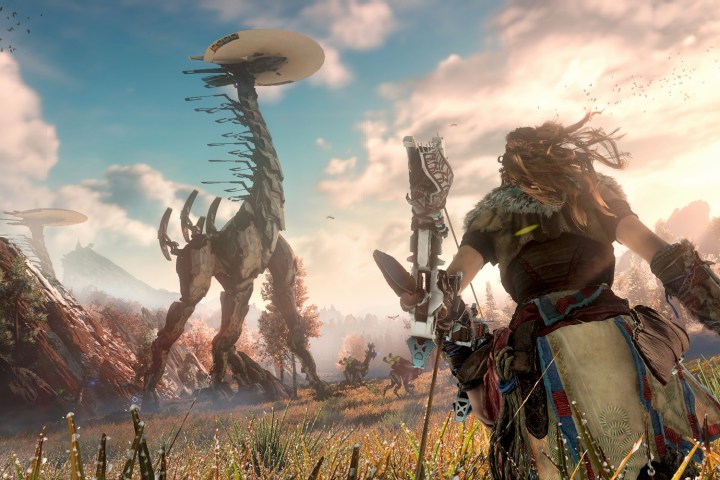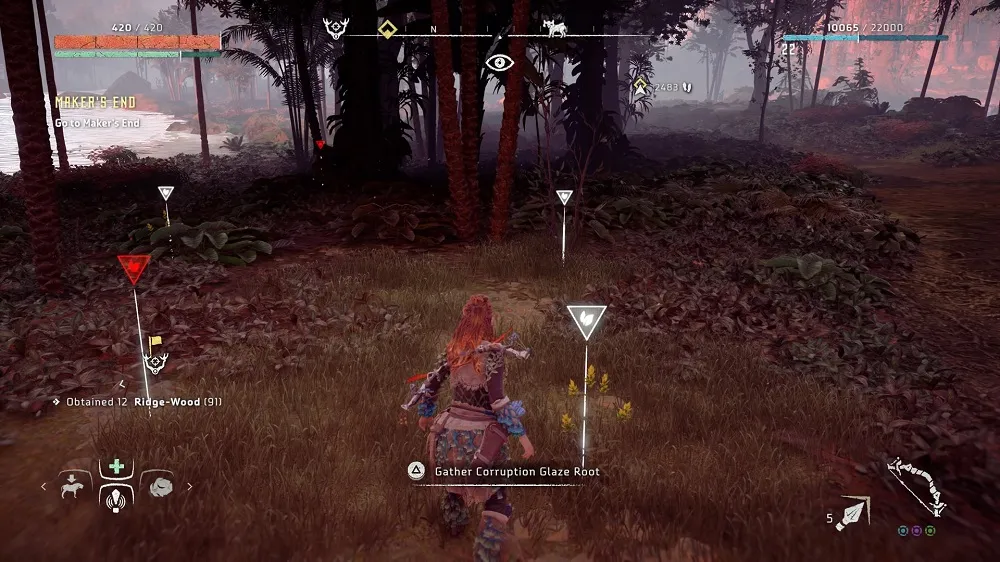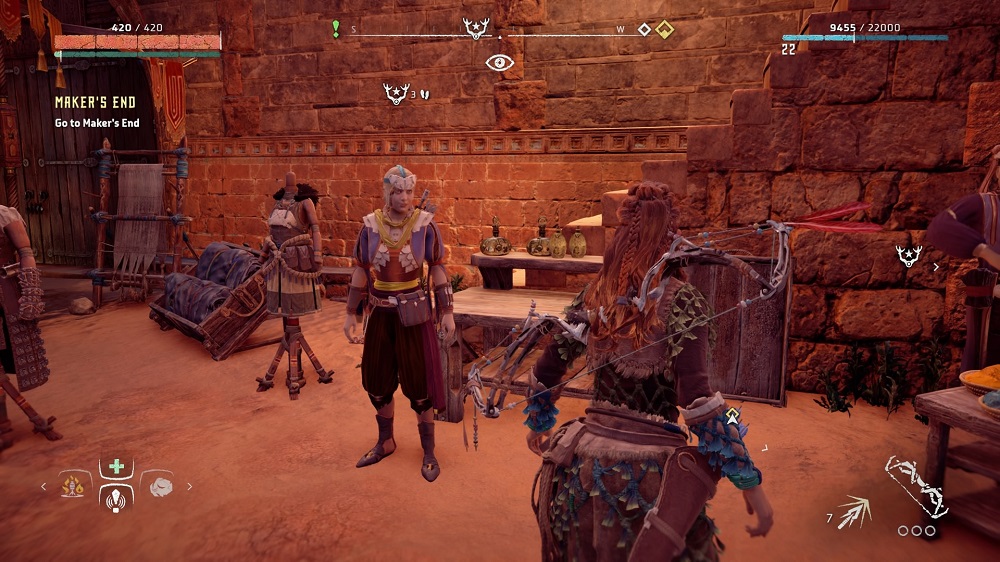
The game is littered with crafting materials — so much so, in fact, that the real challenge becomes about prioritizing the right stuff to gather, and when. Within a few hours, players will often find their pockets overflowing with stuff they don’t actually need. The trick is selling often, hunting regularly, and making upgrades as soon as they become available.
Here’s our complete guide to getting Aloy set with the best possible stuff as quickly as possible.
Hunting and gathering
Step 1: Hunt machines

You spend a lot of time sneaking up on and killing machine enemies in Horizon, which is essential to keeping your stock of weapons and materials full. Every machine you loot will give you metal shards, which are like bullets in post-apocalyptic games such as Metro. Shards are both currency and ammo; you use them to make arrows, but you’ll also spend them like money when you interact with merchants.
Machines give you basically everything you need for your weapons, including Blaze to create fire weapons, Chillwater to create freezing weapons, and Sparkers to create shock weapons. Different machines will also drop items that you can sell or trade. Bits like Lenses and Hearts, which are specific to each type of machine, will be useful later on.
It’s worth it to always harvest machines. Common resources, such as shards and wire, are something you’ll always need. Other things, like Blaze, will start to pile up and you can sell the excess.
Step 2: Hunt animals whenever you see them

What’s not immediately clear when you start Horizon, is that while you’ll want to harvest machines for ammunition, you’ll also want to hunt non-robotic animals. You won’t need stuff from them immediately, or as often as machine parts, but animals are essential to most of your equipment upgrades that let you tote additional baggage. Meat is also necessary for crafting health potions, which can save your life when things get hairy.
Shoot animals whenever it’s convenient to do so and try to start stockpiling skins, meat, and bones. They drop with different rarities but almost immediately, you’ll start to find you’ve got the resources necessary to upgrade Aloy’s carrying capacity, which takes off some of the burden of inventory management. Later in the game, you’re going to want fox skins in particular, because they’ll let you craft an endless fast travel pack. Early on in the game, fast travel requires an expendable item you can make, but once you’ve opened up a lot of the map, you’re going to want a more convenient way of getting around. Fox skins are rare drops, however, so start stockpiling them as soon as you can.
Step 3: You don’t need to gather everything

It’s tempting as you run around Horizon to grab everything you see. Medicinal herbs are plentiful and necessary to always have on hand, but you’ll probably use plants such as shock and freeze roots far less often. These are used for making traps, and are therefore resources you probably won’t need as frequently.
The most important items to keep a lot of are shards and ridge-wood. Shards are obvious, but ridge-wood is also versatile and necessary for crafting many items. You’ll dump ridge-wood into capacity upgrades, crafting for all kinds of ammo, and fast travel packs. Unlike other resources, you can stack up to 100 units in single inventory square, so you can go pretty nuts gathering it without worrying about it filling your resource bag. You’ll almost always need it, and it’s almost always abundant. If you should find you have too much ridge-wood somehow, just toss the extra or sell it. But it’s something you’re definitely going to use. It’s especially important to have a healthy stock of ridge-wood with you in major battles when you need to fill up your ammo supply on the fly.
Step 4: Check your upgrades often

As you start picking up stuff off the ground and hunting animals, you’ll quickly find you have the required components to upgrade your carrying capacity. Aloy carries a ton of different bags. How many weapons you can carry, how many outfits you can tote, how many modifications you can have on hand — it’s all reliant on carrying capacity, and it can all be upgraded. The early upgrades aren’t particularly expensive, though, and you’ll want to snag them as fast as you can.
You can pop into the Crafting menu to individually check upgrades to see what stuff you have in your inventory and what you’re short on. An easier way, though, is to create “Jobs.” Highlight the bag with the upgrade you still need resources for and hit the Square button, and the task of finding what you need gets added to your “Errands” list. You can even set the upgrade as your active quest if you really, really want to get it done. Mostly, though, it’s just a shortcut for seeing what pieces you still need for an upgrade. They’ll almost always be animal parts, so keep hunting — and don’t forget to snipe some fish whenever you’re near a river.
What to keep and how to upgrade
Step 5: Sell your junk often

Especially early in the game before you’ve upgraded your packs, you’re likely to find yourself maxing out your inventory space. Make a note of where merchants are and sell stuff that you don’t need as often as you can. You can check whether inventory is useful or not on the sale screen — Horizon makes note of what different resources are good for. If an object says it’s only good for sale, it’s safe to get rid of it.
Resources such as Blaze and Shockers only stack up to 50 items before they start taking up additional space, however, and you don’t need a ton of them. Sell your surplus to free up space. Use the resources to buy new weapons and outfits, which will be extremely helpful in taking down tougher machines as you advance through the game.
It’ll be tempting to sell things like Watcher Lenses because you won’t see the immediate use for them, but hang onto them. These items are key to buying new weapons and outfits, which let you change your play style or adapt to different enemies.
Step 6: Keep your Lenses and other rare machine drops

Killing machines always gives you shards and necessary crafting materials like wire. You’ll also often get less-common items such as Lenses, Hearts, and other machine innards. These items aren’t good for crafting, and as mentioned above, it can be tempting to sell them for shards to get them out of your inventory. Resist the urge when you can, however, because they’re much more useful later on.
Merchants will sell you new gear for shards but they usually require something extra, such as a Strider Lens or Snapmaw Heart. When you don’t have one of these less-common items, you’re stuck having to hunt. The good news is, it’s rare if ever that Horizon requires you get a specific weapon to advance the story forward, so you’re almost never forced to go machine hunting.
Still, the chances are very good you’ll pick up a lot of these items just during the course of regular play, so if you’re careful about keeping track of Lenses and Hearts, you’ll have them when you need them — no hunting required. Since rarer machine parts aren’t necessary for crafting, it’s best to hang onto them until they’re useful, rather than selling them for a few quick shards. The good news is that merchants tend to all sell the same things wherever you go, so you can quickly see what parts are worth keeping for later and what aren’t. Unload the items you don’t need and clear space by buying new weapons and outfits on the regular.
Step 7: Shortcut the gather grind with resource boxes

Something Horizon tells players but doesn’t broadcast loudly is that your rewards for quests come as “reward boxes,” items that sit in your inventory gathering dust if you forget to open them. These boxes come in a variety of types, but among the ones you receive are resource boxes. They’re exactly what they sound like — pop them open and you’ll get a variety of resources added to your inventory. If you find you’re short on something you need right away, don’t just run out and start wasting your time by hunting and gathering. Pop a few of your stockpiled boxes instead and see if they might have what you need.
It’s much easier to handle your crafting when you’re just hunting and gathering on your way to your next objective. Having to stop and focus on finding a particular animal or plant stalls the pace of the game considerably. It’s possible to avoid focusing on crafting for much of the game if you keep some resources on hand, and boxes can help you skip the grind even more, so you can keep hunting dinosaurs and advancing the story.
Step 8: Get the “Tinker” skill so you can reuse your modifications

One bag you’ll want to upgrade quickly is the one that holds your Modifications. These are rare drops you get from quest rewards or off machines, and they let you plug in powerful upgrades to your weapons and armors. One way to keep your upgrade bag clear so you don’t miss out on picking up good mods is to install them in your weapons and other gear. You’ll want to do that anyway, just to make sure your stuff is as powerful as it can be. But once you’ve installed a modification into a weapon, it’s stuck there. You can replace it with a new one anytime, but when you do, you lose the original. That means you can’t easily recombine your gear to maximize your weapons for the situation you’re in.
There’s a workaround, however, in the “Tinker” perk, found in the “Forager” upgrade menu. It’s expensive — it’s a fourth-tier skill, after all — but try to unlock it as soon as you can. It’ll save you from wasting your best mods on weapons or armor you barely use.


